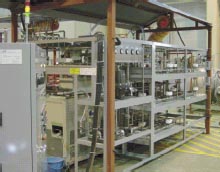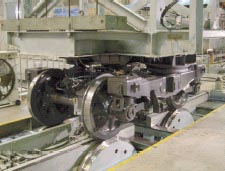 Fig. 1 Fuel Cell Balance of Plant |
 Fig. 2 Driving Tes Equipment | ||||||||
|
|
| Takamitsu YAMAMOTO Senior Researcher, | Kei-ichiro KONDO Senior Researcher, | Takemasa FURUYA Researcher, | ||
| Drive Systems, Vehicle Control Technology Division | ||||
Demands for energy saving and lower environmental burdens are increasing throughout the world, under the motto of global environment preservation. Within this context, fuel cells that use hydrogen as a clean and efficient source of energy to motive transport vehicles are drawing attention.
The Railway Technical Research Institute (RTRI), based on past studies, launched the development of railway cars that use fuel cells in fiscal 2001, and herewith reports the results of a driving test conducted using actual railway car bogie.
In this test, the electricity generated by the fuel cells in the fuel cell balance of plant (Figure 1) was feeded to the motor in a bogie via an inverter (power conversion unit) in order to drive the bogie. The bogie was set for test purposes on a pseudo driving test equipment (Figure 2, Driving Test Equipment) where the parts corresponding to the rails revolve (Figure 3).
The fuel cells (stacks) used for the test is a polymer electrolyte fuel cell (PEFC), which is currently the fuel cell whose development is the most advanced for automotive and other applications. A fuel cell balance of plant
consisting of four stacks that each output 7.5 kW was used, for a total output of 30 kW. This output capacity is rather small for railway vehicle traction sake, and thus the acceleration used in the traction test was 1 km/h/s, approximately 1/3 of the performance required of state of the art commuting trains, but still sufficient to reach a speed of 50 km/h. As shown in Figure 4, the test produced good results.
The success of this test marks one step forward toward a feasible fuel cell system for railway cars. However, fuel cells are currently very expensive and cannot be used right away as an energy source to replace diesel engines for a non-electrified segment for example. Nevertheless, fuel cell technologies are being developed at a remarkable pace, and higher performance and lower cost can be expected. On the other hand, while application to railway cars is advantageous in terms of greater permitted weight and installation space compared to the applcation of automobiles, exacting conditions are imposed with regard to output and life. Therefore, at RTRI, we plan to continue actively developing fuel cell system technologies for railway cars.
Our technology development activities are subsidized in part by the Land, Infrastructure and Transportation Ministry.
 Fig. 1 Fuel Cell Balance of Plant |
 Fig. 2 Driving Tes Equipment | ||||||||
|
|